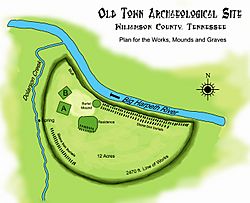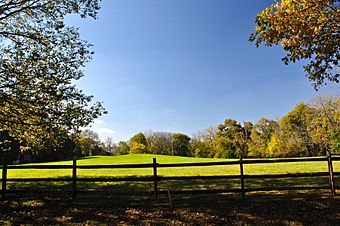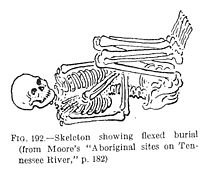Old Town (Franklin, Tennessee) facts for kids

Diagram of placement of mounds and works at the Old Town Archaeological Site
|
|
| Location | Franklin, Tennessee, Williamson County, Tennessee, |
|---|---|
| Region | Williamson County, Tennessee |
| Coordinates | 35°59′38.44″N 86°56′11.36″W / 35.9940111°N 86.9364889°W |
| History | |
| Cultures | Mississippian culture |
| Site notes | |
| Architecture | |
| Architectural styles | platform mounds, plaza |
| Architectural details | Number of temples: |
|
Old Town Archaeological Site
|
|

Old Town Archeological Site, October 2014.
|
|
| Lua error in Module:Location_map at line 420: attempt to index field 'wikibase' (a nil value). | |
| Nearest city | Franklin, Tennessee |
| Area | 41 acres (17 ha) |
| MPS | Mississippian Cultural Resources of the Central Basin MPS (40WM2) |
| NRHP reference No. | 89000159 |
| Added to NRHP | 1989 |
| Responsible body: State | |
Old Town is an important archaeological site in Williamson County, Tennessee, near Franklin, Tennessee. It holds the remains of an ancient Native American village and large earth mounds. These structures were built by people of the Mississippian culture. The site is officially recognized as the Old Town Archaeological Site and is listed on the National Register of Historic Places.
Contents
Discovering Old Town's Past
People have known about "Old Town" for a long time. The first archaeological studies happened in 1868. A doctor named Joseph Jones tried to explore the site. He found a cool frog statue outside a flower garden.
Later, in 1928, road workers accidentally found a large burial ground. A local person worked hard to record what they found. Since then, there haven't been many big digs. However, small parts of the site have been explored when new buildings or pipes were put in. This work helped researchers learn more about the area.
Life in the Ancient Village
The Old Town village and mound complex is located where the Harpeth River and Dolorson Creek meet. This area was part of the Natchez Trace, an old pathway. Scientists have found items at the site that are about 900 to 1450 years old.
In 1876, Joseph Jones wrote a detailed report about Old Town. He described how the village was surrounded by tall earth walls. These walls formed a large semicircle, over 2,400 feet long. Parts of the walls had a wooden palisade, which was like a strong fence. This fence likely helped protect the village.
Inside the walls, there was a village area with several large earthen mounds and a central open space called a plaza. The Mississippian people built different kinds of mounds. Jones described two platform mounds and two burial mounds.
Mounds and Their Purpose
Mississippian mound complexes, like Old Town, were important places. They were centers for community events and religious ceremonies. They were also where the leaders of the community lived.
The largest platform mound, called Mound A, was about 112 feet long, 65 feet wide, and 11 feet tall. The second one, Mound B, was 70 feet long, 65 feet wide, and 9 feet tall. Across the plaza, there was a smaller burial mound. Another burial mound is now the location of the Thomas Brown House.
In the 1980s and 1990s, the Tennessee Division of Archaeology did more small digs. They found items that showed the main time people lived at Old Town was between 1250 and 1450. They even used radiocarbon dating on some charcoal from a trash pit. This showed a date of 1214, confirming when people lived there.
Stone Box Graves
Many burials found at Old Town are called stone box graves. Joseph Jones explored at least 50 of these graves. This type of burial was common for Mississippian people in central Tennessee.
To make a stone box grave, people dug a shallow, rectangular hole. They lined the bottom and sides with flat, thin pieces of limestone. Then, they placed the person's body inside. Finally, they covered the grave with another stone slab. Most of these graves were found along the banks of the river and creek.
Old Town's Historical Recognition
A larger area of about 41 acres was added to the National Register of Historic Places in 1989. It was named the "Old Town Archaeological Site." This was part of a bigger effort to recognize Mississippian cultural sites in the Central Basin area.
The name "Old Town" is also used for the Thomas Brown House. This house was built near the mound complex in the 1840s or 1850s. You can also find the name "Old Town" in the nearby Old Town Bridge. This bridge carried the Harpeth River branch of the Natchez Trace over Brown's Creek.



